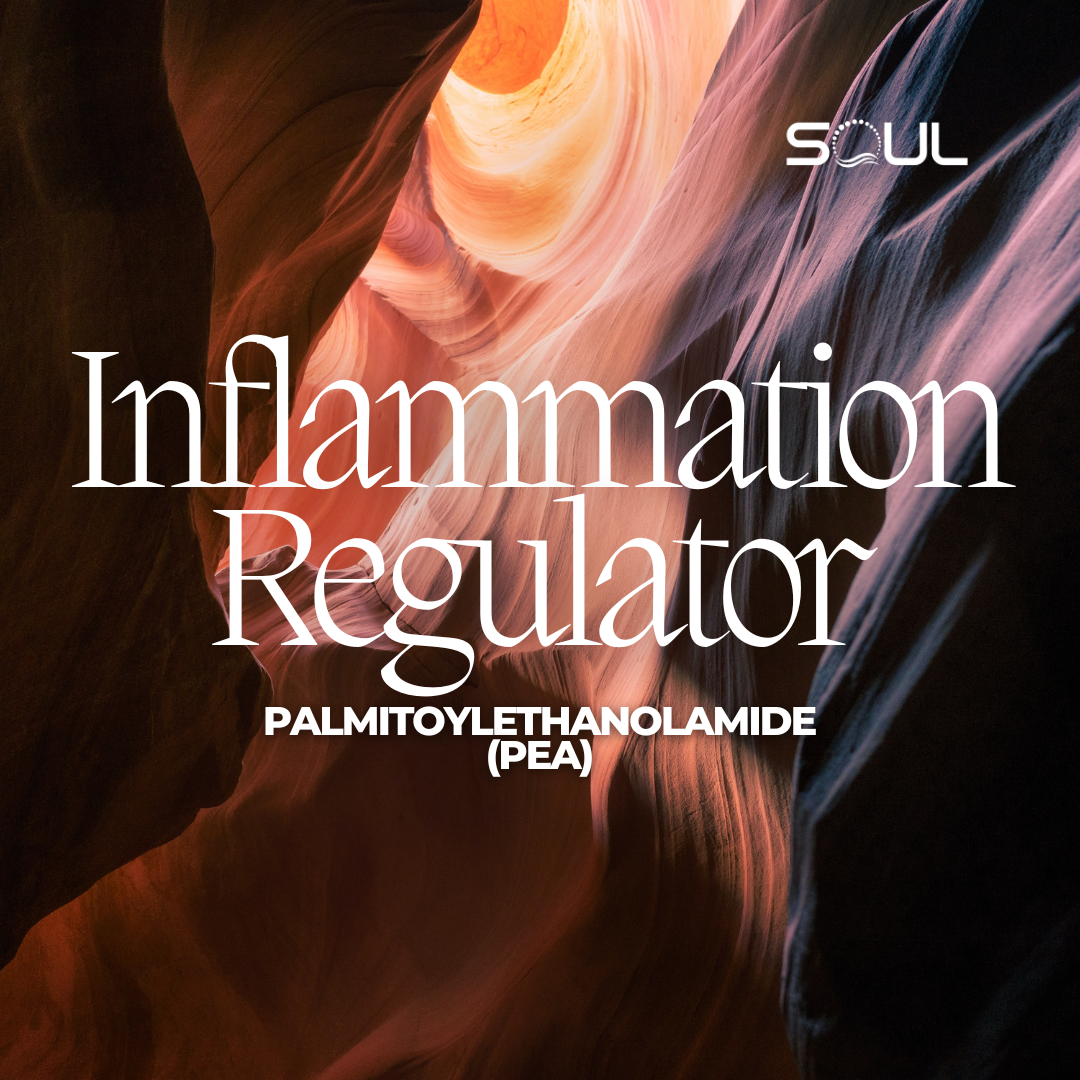
Palmitoylethanolamide: Nature's Best-Kept Secret Against Inflammation
Imagine a shield within your body, a natural defender ready to combat the daily onslaught of injuries, toxins, and microscopic invaders. This shield is inflammation—a critical response that rallies your immune system to protect and heal. But what happens when this defender turns into a rogue agent, waging war on your own tissues and leading to chronic ailments?
Chronic inflammation is more than just an unwelcome guest; it's a silent saboteur disrupting your health and well-being. Synthetic drugs promise relief but often deliver a Pandora's box of side effects and dependencies. Isn't it time we looked to nature for answers?
Enter Palmitoylethanolamide (PEA)—a mouthful to pronounce but a marvel in action. This naturally occurring compound is your body's ally, a guardian angel working at the cellular level to restore balance and banish chronic inflammation.
The Unsung Hero: Understanding Inflammation and Immunity
Let's start with the basics. Inflammation is your body's first responder—a biological alarm system reacting to cuts, bruises, germs, and harmful substances. It's the redness around a wound, the swelling of a sprain, the heat of a fever—all signs that your immune system is hard at work.
But when the balance tips—when pro-inflammatory agents outpace anti-inflammatory ones—this protective mechanism spirals into a chronic condition. Continuous stressors keep the immune system on high alert, leading to persistent inflammation that doesn't just affect a single organ but can trigger a domino effect of health issues.
Synthetic anti-inflammatories might offer a quick fix, but at what cost? Addiction, side effects, and a weakened natural defense system are steep prices to pay. Surely, there's a better way.
Meet PEA: Nature's Answer to Chronic Inflammation
Discovered in the 1950s and introduced to the Western market in 2008, Palmitoylethanolamide (PEA) is a fatty acid amide found throughout your body. Think of PEA as a skilled mediator, stepping in when and where it's needed to soothe inflammation and modulate pain.
PEA doesn't just mask symptoms; it addresses the root causes by interacting with specific receptors and cells involved in inflammation and immunity. Over 350 scientific papers applaud its versatility:
- Anti-Inflammatory and Pain Relief: PEA targets mast cells and glial cells, the culprits behind chronic pain and prolonged inflammation.
- Neuroprotection: It safeguards nerve cells, offering hope for neurodegenerative conditions.
- Immune System Modulation: PEA fine-tunes your immune response, preventing overreactions like cytokine storms.
But how does PEA work its magic?
The Science Behind PEA: A Symphony of Cellular Interactions
PEA operates on multiple fronts, a multitasker par excellence:
- Activating PPAR-α Receptors: By binding to these nuclear receptors, PEA reduces the production of pro-inflammatory cytokines—those pesky proteins that fuel inflammation.
- Interacting with Cannabinoid Receptors (GPR55 and GPR119): These interactions help regulate pain perception and inflammation.
- Modulating the TRPV1 Receptor: PEA influences this receptor involved in pain and heat sensation, helping to alleviate discomfort.
By engaging these pathways, PEA doesn't just put out fires; it prevents them from starting.
PEA and the Immune System: Mastering Macrophages and Cytokines
At the heart of your immune response are macrophages—the frontline soldiers gobbling up pathogens and signaling other immune cells into action. But sometimes, these soldiers get overzealous, leading to an overproduction of cytokines and resulting in a dangerous cytokine storm.
This is where PEA shines:
- Regulating Macrophage Activation: PEA ensures these cells respond appropriately, avoiding excessive inflammation.
- Reducing Pro-Inflammatory Cytokines: By decreasing levels of TNF-α, IL-1β, and others, PEA keeps the inflammatory response in check.
- Suppressing NF-κB Expression: This further curtails the genes responsible for inflammation.
The result? A balanced immune response that effectively combats infections without collateral damage to your own tissues.
Gut Feeling: PEA's Role in Digestive Health
Your gut is more than a digestion machine; it's a complex ecosystem crucial for immunity. Chronic inflammation here can wreak havoc—altering the microbiome, increasing gut permeability, and inviting infections.
PEA offers a remedy:
- Protecting the Gut Lining: By acting on PPAR-α receptors in the colon, PEA reduces inflammation and heals damaged tissues.
- Balancing the Microbiome: It helps maintain a healthy microbial population, essential for both digestion and immune function.
- Preventing Behavioral Changes: By keeping gut health in check, PEA may also influence mood and cognitive functions linked to gut-brain interactions.
In essence, PEA restores harmony in the gut, bolstering your first line of defense against disease.
Brain Trust: PEA's Defense Against Neurological Threats
Chronic inflammation doesn't stop at the gut—it can compromise your brain's health. Cytokines can cross the blood-brain barrier, leading to neuroinflammation and increasing the risk of neurodegenerative diseases.
PEA steps up as a neuroprotective agent:
- Enhancing Microglial Phagocytosis: Microglia are the brain's cleanup crew. PEA boosts their ability to remove pathogens and debris.
- Regulating Immune Cells: By influencing macrophages and microglia, PEA promotes efficient immune surveillance in the brain.
- Interacting with CB2 Receptors: This promotes beneficial changes in microglia, enhancing their protective functions.
Studies show that PEA can improve survival rates in bacterial meningitis without antibiotics, highlighting its potential as a natural safeguard for your brain.
The Entourage Effect: Amplifying Natural Defenses
PEA doesn't work alone. It enhances the effects of endocannabinoids like anandamide (AEA) by preventing their breakdown—a phenomenon known as the "Entourage Effect." This synergy amplifies the activation of immune cells, further strengthening your body's defenses.
By replenishing PEA levels depleted by chronic inflammation, you're not just treating symptoms; you're restoring a crucial component of your body's innate ability to heal.
Why PEA Matters: A Natural Path to Wellness
In a world saturated with quick fixes and synthetic solutions, PEA stands out as a natural, effective alternative:
- Safety and Efficacy: With extensive research backing its benefits, PEA offers a proven track record without the side effects common in synthetic drugs.
- Holistic Approach: It addresses multiple systems—immune, nervous, digestive—providing comprehensive support.
- Empowerment Through Nature: Using PEA means aligning with your body's natural processes, promoting genuine healing over temporary relief.
Taking the Next Step: Embrace PEA for Optimal Health
Your health is your most valuable asset. With PEA, you have the opportunity to harness a natural compound that works harmoniously with your body to combat chronic inflammation and bolster immunity.
Don't settle for masking problems. Choose a solution that gets to the heart of the matter—a solution rooted in nature and validated by science.
These statements have not been evaluated by the Food and Drug Administration. This product is not intended to diagnose, treat, cure or prevent any disease. This article is for informational purposes only and is not a substitute for professional medical advice. Always consult your healthcare provider regarding any health concerns or before starting new supplements.
